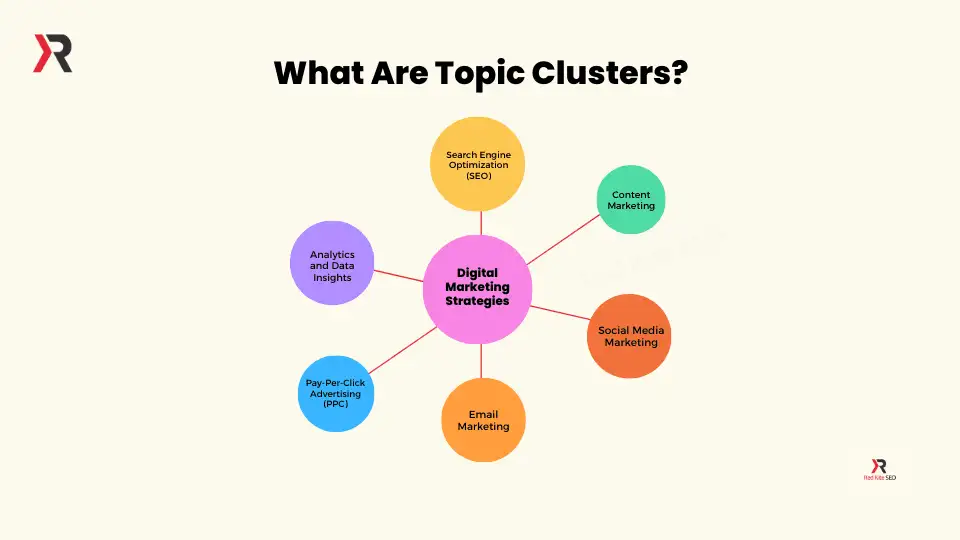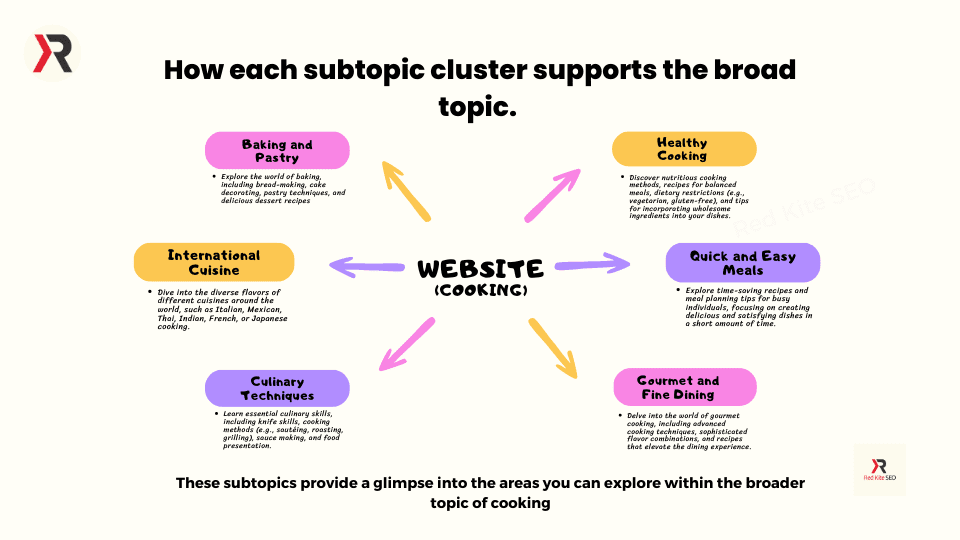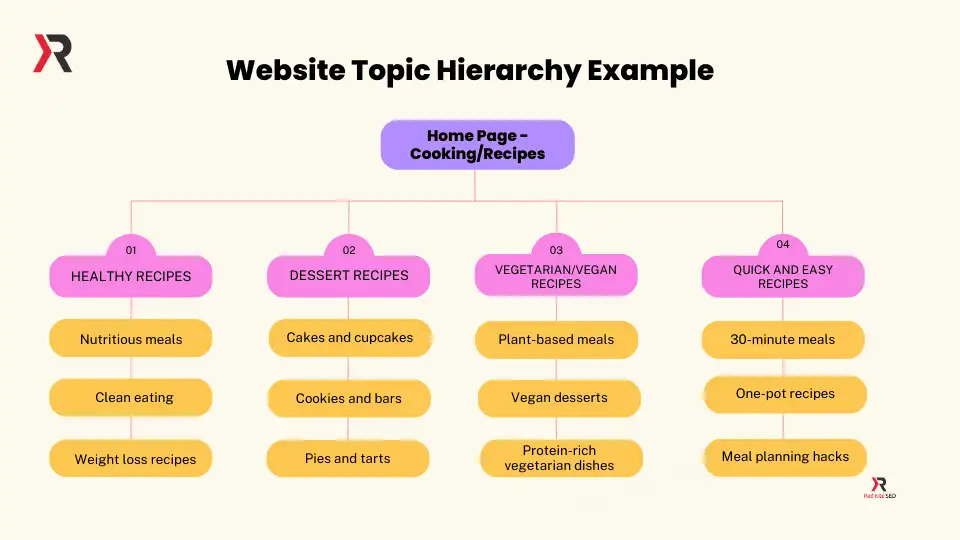Building Topic Clusters in Website SEO: Your Ultimate Guide
Welcome to the world of topic clusters, where relevance, authority, and comprehensive content reign supreme. In this guide, we’ll explore how topic clusters are your go to technique in the realm of search engine optimisation (SEO).
We’ll break down the concept, understand its benefits, and learn how to implement it effectively to boost your website’s visibility, traffic, and overall SEO success. So, let’s dive in and unravel the secrets of topic clusters!
What Are Topic Clusters?

Topic clusters are a game-changer in the world of SEO. They involve grouping related assets and creating a web of interconnected content that addresses user questions and satisfies search intent.
In SEO we mainly use Hierarchical Clustering
Hierarchical clustering produces a hierarchical structure of clusters. It is an ideal approach for data with a hierarchical structure, like taxonomies.
In addition, another advantage is that any number of clusters can be chosen by selecting the number of cluster content (supporting posts) at the right level for your SEO.
At the heart of this strategy lie two essential components: pillar content and cluster content.
- Pillar content serves as the foundation of your topic cluster. It focuses on broad top level keywords and aims to cover the main topic comprehensively.
- cluster content zooms in on specific subtopics (longtail keywords) within the broader theme. By organising your content in this way, you establish authority, increase relevance, and cater to a wide range of user queries.
Each cluster content piece is interlinked with the pillar page and other cluster content, creating a network of interconnected information.
This structure enhances the overall relevance and authority of your website while allowing users to explore related subtopics in-depth.
Why create topic clusters?
Creating topic clusters is essential for improving your website’s search engine optimisation (SEO) and enhancing user experience.
By organising your content into topic clusters, you establish a clear content hierarchy and provide comprehensive coverage of a specific topic.
This structure helps search engines understand the relevance and authority of your website, leading to improved rankings and increased organic traffic.
Additionally, topic clusters enable you to target a wide range of user queries and cater to different search intents, ensuring that you capture a larger audience and drive more targeted traffic to your site.
Why are topic clusters important?
Topic clusters are important because they align with the evolving algorithms of search engines like Google. These algorithms now prioritise content that demonstrates expertise, relevance, and comprehensiveness.
By implementing topic clusters, you can signal to search engines that your website provides in-depth knowledge on a specific topic. This can lead to higher search rankings, increased visibility, and improved organic traffic.
Topic clusters also enhance the user experience by providing organised, interconnected content that addresses various subtopics within a broader theme.
This makes it easier for users to navigate your website, find the information they need, and engage with your content.
The Power of Topic Clusters: Boosting SEO and Driving Web Traffic

Now that we understand the structure of topic clusters, let’s explore the immense benefits they offer to your SEO efforts:
1. Establishing Authority: Topic clusters enable you to demonstrate expertise and establish your website as a go-to resource in your industry.
By covering a topic comprehensively and interlinking relevant content, you showcase your authority and build trust with both users and search engines.
2. Ranking for Less Competitive Keywords: Traditional SEO often focuses on highly competitive keywords, making it challenging to rank.
However, with topic clusters, you can target long-tail and less competitive keywords and search terms associated with specific subtopics. This approach opens up new opportunities to rank higher and attract targeted traffic.(widening the keyword net)
3. Driving Targeted Traffic: By catering to a wide range of user queries through comprehensive topic coverage, topic clusters drive targeted traffic to your website.
Users searching for related information are more likely to discover your content, increasing the chances of engagement by casting a wider net of keywords, helping conversions, and ultimately, business success.
How do you create a topic cluster and pillar page?
(This is an older video that covers the basic cluster concept.)
Implementing Topic Clusters: Best Practises and Strategies
Implementing topic clusters can seem daunting at first, but don’t worry! Here’s a step-by-step guide that makes it a breeze.
Step 1: Identify Broad Topics
Start by brainstorming broad topics that your audience is interested in and that are related to your business or blog. For example, if you run a fitness website, broad topics might include “weight loss,” “nutrition,” or “home workouts”.
Step 2: Create Pillar Content
Next, create comprehensive content, known as pillar content, around each of these broad topics. These pillar pages should provide a thorough overview of the topic at hand, ideally covering all the basic information a visitor should know about the topic.
Step 3: Research Subtopics
For each pillar topic, identify subtopics that delve into more detail. Using the fitness website example, if your pillar content is about “nutrition”,
Subtopics could include:
- “healthy eating habits”
- “meal planning”
- “macros and micros”.
Step 4: Create Cluster Content
Now, it’s time to create content for each of these subtopics. Each piece of content should be informative and in-depth, focusing on one specific subtopic. Don’t forget to naturally incorporate related NLP keywords and entity’s to boost your SEO!
Step 5: Link It All Together
Once your pillar and cluster content is ready, interlink them. This means you should add hyperlinks from each subtopic content piece back to the pillar content, and vice versa. This step is essential for creating the ‘cluster’ part of a topic cluster.
Step 6: Monitor and Refine
Finally, once your topic cluster is live, don’t forget to monitor its performance. Use analytics tools to track how each page is performing in terms of traffic, user engagement, and search engine rankings.
If a certain page isn’t performing as well as you’d like, don’t be afraid to tweak your content or your linking strategy.
Remember, with topic clusters, your goal is to become the go-to resource for your readers on a specific topic. So, don’t rush the process. Take your time to create quality content that your readers will find useful and informative.
As you add more content over time, your topic clusters will become more robust, helping you build authority and improve your SEO performance. And if you need a little help along the way, Red Kite SEO is always here to guide you!
Also Watch How to Create and Plan a Topic Cluster
What is a topic cluster example?

Watch here as Dixon Jones explains about knowledge clusters on the web.
When planning a website, utilising categories to create subtopics is an effective way to organise your content and improve the user experience. Let’s consider a website about cooking as an example:
Here’s an expanded list of keywords for each category page based on the example of a cooking website:
Pillar Page: Recipes
– Recipe ideas
– Cooking techniques
– Meal inspiration
– Culinary tips
– Recipe collections
– Cooking basics
– Recipe categories
– Featured recipes
Subtopic: Healthy Recipes
– Nutritious meals
– Clean eating
– Weight loss recipes
– Low-calorie dishes
– Gluten-free recipes
– Vegan and vegetarian options
– Superfoods
– Meal prep for healthy eating
Subtopic: Dessert Recipes
– Cakes and cupcakes
– Cookies and bars
– Pies and tarts
– Frozen treats
– Chocolate desserts
– Baking tips and tricks
– Festive desserts
– Decadent indulgences
Subtopic: Vegetarian/Vegan Recipes
– Plant-based meals
– Meatless alternatives
– Vegan desserts
– Dairy-free recipes
– Protein-rich vegetarian dishes
– Vegan pantry essentials
– Vegan cooking tips
– Plant-based nutrition
Subtopic: Quick and Easy Recipes
– 30-minute meals
– One-pot recipes
– Instant pot meals
– Sheet pan dinners
– Simple weeknight dinners
– Meal planning hacks
– Make-ahead recipes
– Quick breakfast ideas
These keywords can help guide your content creation and optimise your website’s pages for search engines.
Incorporating these relevant keywords within your subtopic cluster pages will attract organic traffic from users searching for specific recipe categories, cooking tips, and culinary inspiration.
Remember to create valuable and engaging content around these keywords to provide a comprehensive resource for cooking enthusiasts visiting your website.
Start by identifying the main topic, such as “Recipes.”
Create a pillar page dedicated to the main category, providing an overview of different recipe types and cooking techniques.
Then using relevant subtopics or recipe categories that fall under the main category, like the example shown above.
Ensure seamless navigation by linking the subtopic cluster pages to the main pillar page and cross-linking between related subtopics when appropriate.
By utilising categories and creating subtopics, your website becomes a comprehensive resource for cooking enthusiasts.
What are best practises for implementing topic clusters effectively?
1. Optimising Titles and Headings: Crafting optimised titles and headings is crucial for topic clusters. Ensure they accurately represent the content and incorporate relevant keywords to enhance visibility and attract both users and search engines.
2. Internal Links: Internal linking is the glue that holds your topic clusters together. By linking related content within your website, you create a web of interconnectedness, allowing users and search engines to navigate through your content seamlessly.
This practise boosts your SEO efforts and strengthens the authority of your website.
3. Avoiding Keyword Cannibalization: Keyword cannibalization occurs when multiple pages on your website compete for the same keyword, resulting in a dilution of your SEO efforts.
To prevent this, ensure that each piece of content within your topic cluster has a distinct focus and targets specific keywords.
4. Building Backlinks to Pillar Pages: To solidify your website’s authority and boost its long-term SEO success, it’s essential to build high-quality backlinks to your pillar pages. Backlinks from reputable sources signal to search engines that your content is valuable and trustworthy, leading to improved rankings and increased organic traffic.
Filling the Content Gaps: Bridging the Online Information Divide
![]()
(Cooking website example)
While topic clusters offer a powerful SEO strategy, it’s important to identify any underserved topics or content gaps within your industry.
In today’s digital landscape, addressing content gaps is crucial for establishing your brand as a knowledgeable and authoritative voice within your industry.
By bridging these gaps, you can provide valuable information and insights to your target audience while positioning yourself as a go-to resource.
Here’s a step-by-step guide to help you address the online content gap on a topic in your industry:
1. Identify the Gap: Start by conducting thorough research to identify areas within your industry where there is a lack of comprehensive or up-to-date information. Look for topics or subtopics that are underrepresented or not adequately covered by existing content.
This could include:
- emerging trends
- niche subjects
- specific challenges faced by your target audience.
2. Understand User Intent: Once you’ve identified the content gap, delve deeper into the needs and intentions of your target audience. Gain insights into the specific questions they have, the problems they need solutions for, and the information they are seeking.
This will help you tailor your content to address their unique needs effectively.
3. Conduct In-Depth Research: To fill the content gap, it’s crucial to gather accurate and reliable information. Conduct extensive research using:
- reputable sources
- industry reports
- case studies
- expert opinions.
This will ensure that your content is well-informed, credible, and provides valuable insights to your audience.
4. Create Comprehensive and Authoritative Content: Armed with your research findings, create high-quality, comprehensive content that addresses the content gap effectively. Craft informative blog posts, in-depth articles, or even downloadable resources such as whitepapers or guides.
Provide detailed explanations, actionable tips, and practical solutions to establish your brand as a trusted source of information.
5. Optimise for Search Engines: As you create content, ensure that it is optimised for search engines. Conduct keyword research to identify relevant keywords and incorporate them naturally throughout your content.
This will help search engines understand the relevance of your content to user queries and improve its visibility in search results.
6. Promote and Share: Creating great content is only the first step. To bridge the content gap effectively, you need to promote and share your content with your target audience.
- Leverage social media platforms
- industry forums
- email newsletters
- and partnerships with influencers
- or industry experts
To spread the word about your valuable content.
Engage with your audience, encourage discussions, and invite feedback to foster a sense of community around your brand.
7. Continuously Update and Improve: The digital landscape is constantly evolving, and new information emerges over time. To maintain your position as a trusted resource, regularly update and improve your content.
Stay up-to-date with industry trends, incorporate new research findings, and respond to user feedback. By continuously refining and expanding your content, you ensure its relevance and long-term value.
By following these steps, you can effectively address the online content gap in your industry and position your brand as a leading authority.
Red Kite SEO understands the importance of content gap analysis and can assist you in implementing a comprehensive content strategy to fill those gaps.
Let Red Kite SEO be your partner in providing valuable information and bridging the online information divide within your industry.
Conclusion on Topic Clusters

Topic clusters are indeed a game-changer in the world of website SEO. By strategically organising your content and leveraging internal linking, you can establish authority, drive targeted traffic, and enhance your website’s overall performance.
Remember, the power of topic clusters lies not only in their ability to optimise your SEO efforts but also in their capacity to address user needs and deliver comprehensive, valuable information.
So, let Red Kite SEO guide you through the realm of topic clusters and unlock the true potential of your website’s SEO strategy.
With their expertise in branding services, content creation, and cutting-edge SEO techniques, Red Kite SEO is your ultimate partner in achieving digital success.
Embrace the power of topic clusters and watch your website soar to new heights in the search engine rankings.

Pete Hogg is an accomplished SEO consultant with a proven track record of driving organic traffic and boosting online visibility. With 8 years of experience in the ever-evolving world of digital marketing, he has helped businesses achieve top rankings on search engines. A passionate advocate for SEO best practises, Pete Hogg combines technical expertise with a deep understanding of content strategy to deliver results that matter. When not optimising websites, he enjoys wheelchair rugby. Connect with Pete Hogg to take your online presence to the next level.

